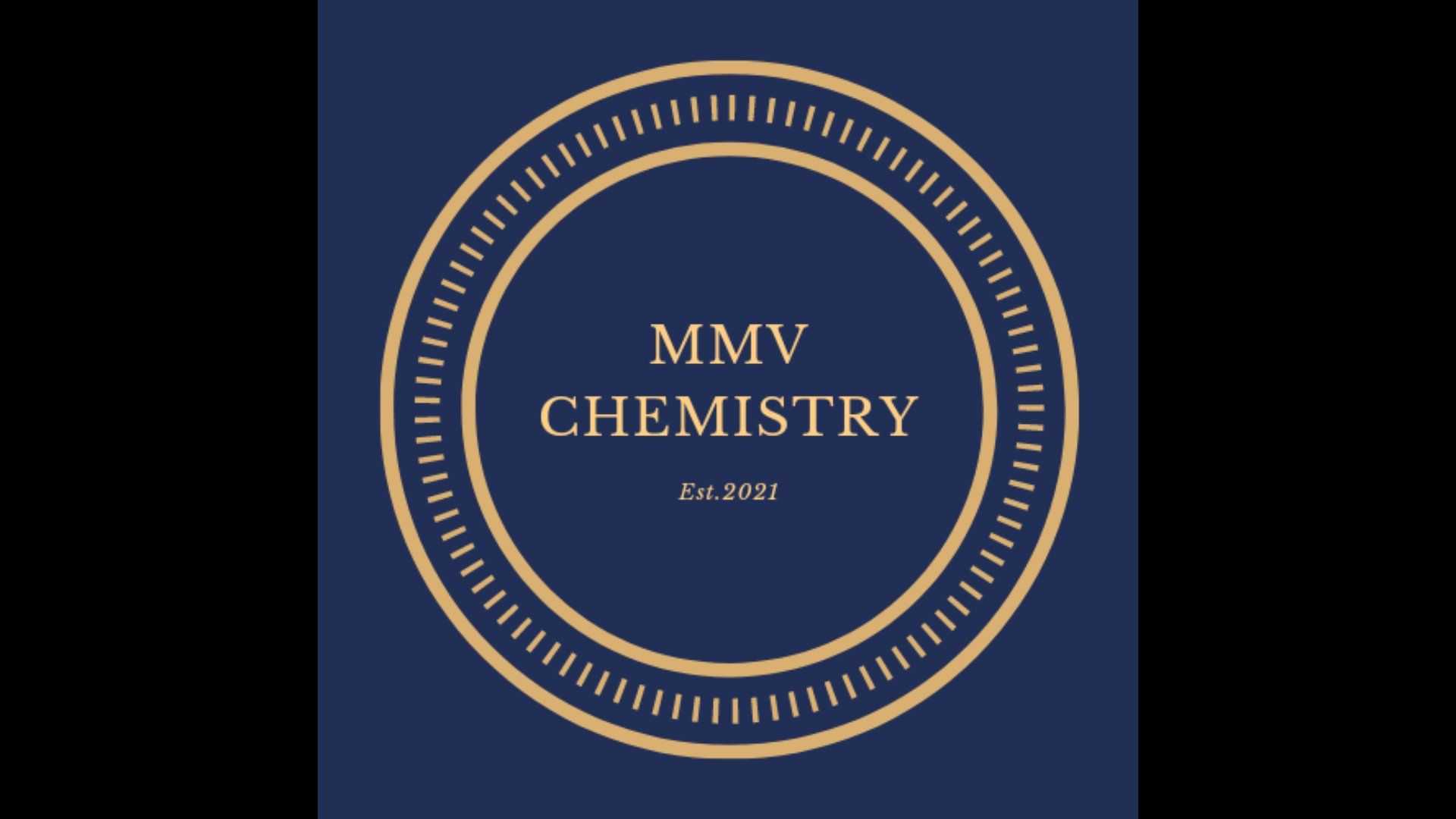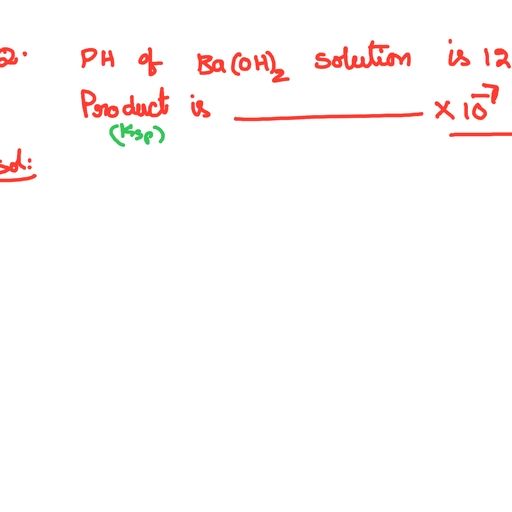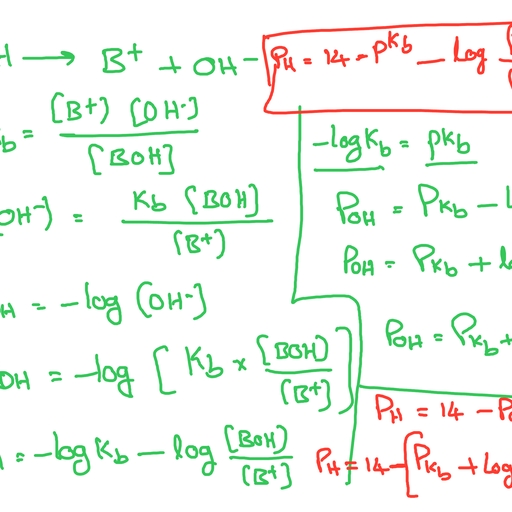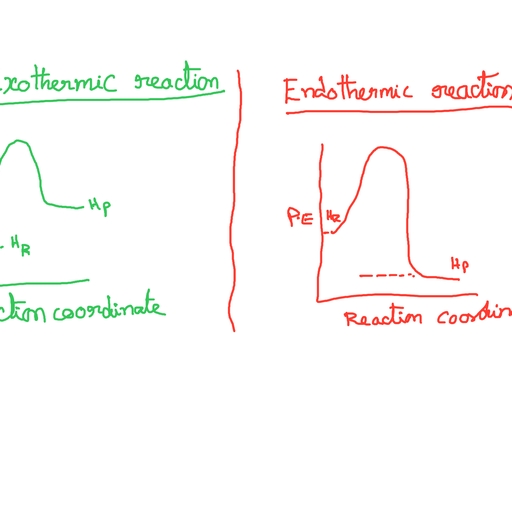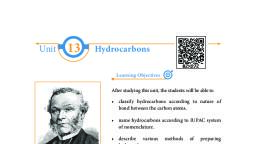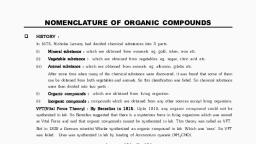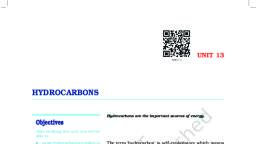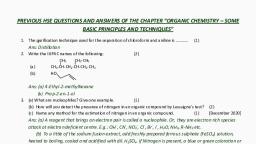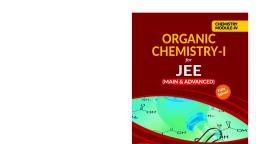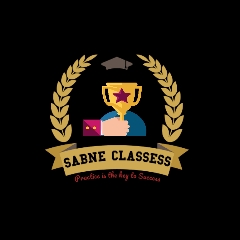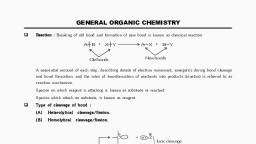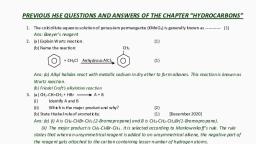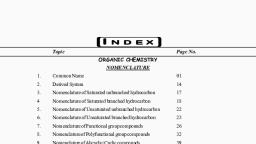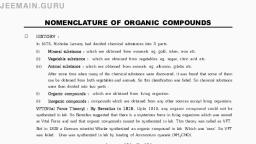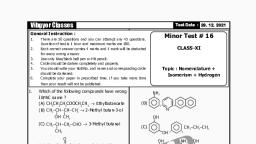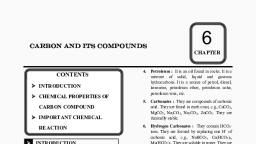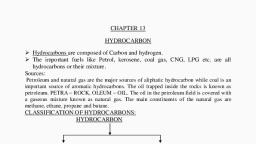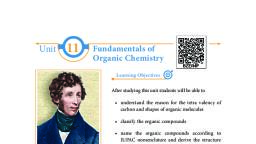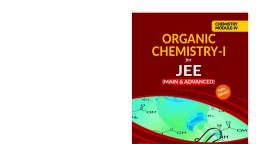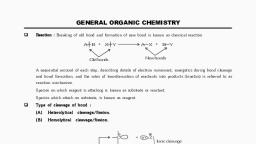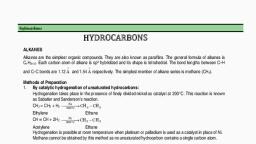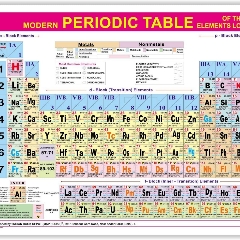Page 1 :
ORGANIC CHEMISTRY, SOME BASIC PRINCIPLES, , , SYNOPSIS, Introduction, , , , , , , , , , Organic Chemistry is the branch of Chemistry, which deals with study of organic compounds., Lemery (1675) divided the natural chemical, compounds into three classes based on their, sources as (a) Compounds of mineral origin (b), Compounds of vegetable origin (c) Compounds, of animal origin, Lavoisier (1784) showed that all compounds, obtained from vegetable and animal sources, always contained Carbon and Hydrogen,, sometimes Nitrogen and Phosphorus also, In the reclassification of organic compounds, Berzelius (1807) introduced the new terms, “Organic” & “Inorganic”., The word ‘organic’ has been coined from the, ‘organism’, , , , , , , , , , , Modern definition of organic, chemsitry, , , , , , , The simplest orgnic compounds containing, carbon and hydrogen o nly are called, hydrocarbons while all other organic compounds, are considered to have been derived from them., Thus, organic compounds may be defined as, hydrocarbons and their derivatives and the, branch of chemisry which deals with the study of, hydrocarbons and their derivatives is called, Organic Chemistry., According to the Vital Force theory, proposed, by Berzelius organic compounds were from living, organisms and they were produced under the, influence of a vital force, they cannot be prepared, in the lab artificially., Urea is the first organic compound prepared in, the lab by Wohler. Vital force theory has lost its, significance after synthesis of urea by Wohler., , , , , , , , , , , , NH 4CNO , NH 2CONH 2, on tautomerisation, , ammonium Cyanate Urea, First organic compound prepared from its, elements in the lab is CH 3COOH . It was, prepared by Kolbe., Second organic compound prepared from its, elements in the lab is CH 4 . It was prepared by, Berthelot., The ability of carbon atom to form long chains, or rings is known as catenation., The element with highest catenation ability in, periodic table is carbon., Carbon is tetravalent. Tetravalency of carbon was, proposed by Vant Haff and Label., Organic compounds are numerous in number, (almost 107 ) due to, (a) Maximum catenation capacity of carbon, (b) Tetravalency of carbon, (c) Isomerism in organic compound of carbon, (d) Carbon has Tendency to form multiple Bonds, The main natural sources of organic compounds, are coal, petroleum, natural gas, animals and, plants., Organic compounds are vital for sustaining life, on earth and include complex molecules like, genetic information bearing DNA and proteins, that constitute essential compounds of our blood., Organic chemicals appear in material like, clothing, fuels, polymers, dyes and medicines., Formal charge = (group number in the periodic, table) - (no of bonds) - (no of unshared, electrons)., The development of electronic theory of covalent, bonding helped organic chemistry for its modern, shape
Page 2 :
ORGANIC CHEMISTRY - SOME BASIC PRINCIPLES & TECHNIQUES, , JEE MAINS - VOL - IV, , Structure and Bonding, State of Carbon in Carbon, compounds, , , , , , , , , , , , , , , The ground state electronic configuration of, carbon is 1s2 2s2 2px1 2py1 2pz0, The excited state electronic configuration of, carbon is 1s2 2s1 2px1 2py1 2pz1, Energy of excitation is 120 K.cal mol-1 or 501.6, KJ mol-1, The tetravalence of carbon and the formation of, covalent bonds by it are explained in terms of its, electronic configuration and the hybridisation of, s and p orbitals, In organic compounds carbon atom undergoes, sp, sp2 and sp3 hybridisations., , sp3 carbon is called saturated carbon., sp and sp2 carbons are called unsaturated, carbons., Greater the s - character the lower the energy, and thus near to the nucleus i.e. orbital is smaller., The order of size of different orbitals is p > sp3 >, sp2 > sp > s, The change in hybridisation affects the, electronegitivity of carbon., The greater the s character of the hybrid orbitals,, greater is the electronegativity, E.N of carbon with sp > carbon with s p 2 >, carbon with s p 3, % S character electronegativity of carbon, , 27, , NISHITH Multimedia India (Pvt.) Ltd.,
Page 3 :
ORGANIC CHEMISTRY - SOME BASIC PRINCIPLES & TECHNIQUES, , GOCMAINS, & ISOMERISM, JEE, - VOL - IV, , , , , , , In (pi) bond formation, parallel orientation of, the two ‘P’ orbitals on adjacent atoms is, necessary for a proper sidewise overlap, In H2C CH 2 molecule. The ‘P’ orbitals, mutually parallel and both the p orbitals are, perpendicular to the plane of the molecule., Rotation about C - C double bond in C = C is re, stricted., , Determination of Hybridisation in, Organic Compounds, Hybridisation in organic compounds can be, known by follwoing two methods:, A) First method :, Number of pi bonds types of hybridisation, Zero, sp3, One, sp2, Two, sp, , Determination of bond pairs : Number of bp =, Number of atoms present on central atom of the, species or number of sigma bonds present on, central atom of the species., , Determination of lone pair of, electrons, Number of lp’s can be determined as follows:, i) If carbon has pi bond (s) or positive charge or, odd electron, then lp on carbon will be zero., ii) If carbon has negative charge, then lp will be, equal to one., Number of electron pairs tells us the type of, hybridisation as follows:, ep, hybridisation ep hybridisation, 2, sp, 5, sp3d, 3, sp2, 6, sp3d2, 3, 4, sp, 7, sp3d3, Examples:, , C H3 C H C H C C C H3, , , SP3, , , , SP 2, , , , SP 2, , , , , , SP, , SP, , SP3, , B) Second method: Electron Pair method, ep = bp + lp, where, ep = electrons pair present in hybrid orbitals, bp = bond pair present in hybrid orbitals, lp = lone pair electrons., 28, NISHITH, Multimedia India (Pvt.) Ltd.,, , , , H 2C C H, , , , , , bp 2, lp 0, , i), , , ep 2, sp, , Narayana IIT/PMT Academy, , 28
Page 4 :
GOC & ISOMERISM, H|, H CO N O, , , , H 3C C H CH 3, , , |, , bp 3, lp 1, , ii), , , , H, , , , ep 4, sp 3, , , HC C, , , bp 1, lp 1, , iii) , ep 2, sp, , Final structure, Atom which have fewer electrons than 8 use, unshared pairs on adjacent atoms to form doubtle, or triple bond to complete the octet., It is most stable structure for methyl nitrite, because, hydrogen atoms have duplet and all other atoms, have octet, , H, |, H C O N O, |, , , , H, , H 3C C CH 3, |, , , , CH 3, bp 3, lp 0, , iv) , , calculation of formal (+ve and -ve ) charges, methyl nitrit has two resonance structures, , H, |, , ep 3, sp 2, , H C O N O, |, , Writing systematic lewis structures, , , , , , , , CH 3 NO 2 ., All hydrogens are connected to C - atom and, the order of atomic connections in the above, example is CONO, Total valence electrons can be counted as :, H 1 3 03, C 4 1 04, O 6 2 12, N 5 1 05, -----24, -----Ist partial structure, 6bonds (shared pairs ) equivalent to 12 electrons, H|, H C O N O, |, , H, , , , H, , The molecular formula of methyl nitrite is, , 2nd partial structure, provision of an octet for all atoms (exept, hydrogen atom) by using remaining 12 electrons, , Narayana IIT/PMT Academy, , H, |, , +, , H CO N O, |, , (M), , H, , (T), , structure - I, structure - II, In the structure-I. there are no formal charges, and in, structure-II there are formal charges.the, structure -I, with no formal charges its more stable than the, structure -II with formal charges, , Formula, Formal charge, Q f = GN - No. of bonds - No., of unshared electrons, In the structure - II, The formal charge on oxygen atoms, T=6 - 1 - 6 = -1,, M=6 - 3 - 2 = +1, formal charge on nitrogen atom = 5-3-2=0, , 29
Page 5 :
structural representation of organic Examples of bond line structures, molecules, 1., , 2., , Structures of organic compounds are represented, in several ways. The Lewis structure (or) dot, structure, dash structure, condensed structure and, bond line structure., Example of complete structural formula, |, |, , |, , .., .., , H, , Examples of condensed structural formula, , 4., , CH 3CH3 H2C CH 2 HC CH CH 3OH, (ethane) (ethene), (ethyne) (methanol), similarly CH 3CH 2 CH 2 CH 2 CH 2 CH 2 CH 2 CH 3, can be further condensed to CH 3 CH 2 6 CH 3, 4., , Example of bond line representation, , 5., , The various ways of representing 2 - bromo, butane are:, , 6., , Br, |, , CH 3 CH CH 2 CH3, , or, , 7., 6., , 3, , H C O H, , H H, 3., , 2., , H, , H H, |, |, H C C H, |, , 1., , In cyclic compounds, the bond - line formulas, may be given as follows, , 5., , .
Page 6 :
ORGANIC CHEMISTRY - SOME BASIC PRINCIPLES & TECHNIQUES, , JEE MAINS - VOL - IV, , Classification of Organic Compounds, , Organic compounds, , Acyclic or Open, chain compounds, , Saturated, hydrocarbons, , Un saturated, hydrocarbons, , Cyclic or Closed chain, or Ring compounds, , Homocyclic or, Carbocyclic, compounds, , Alicyclic, compounds, , Heterocyclic, compounds, , Aromatic, compounds, , Benzenoid, compounds, , Aromatic, compounds, , Non- Aromatic, compounds, , Non-Benzenoid, compounds, , Cyclic compounds, Acyclic Compounds, Organic compounds in which all the carbon atoms, are linked to one another to form open chains, (straight or branched) are called acyclic or open, chain compounds., Saturated:, , CH 3CH 2 CH 2 CH 3, Butane, , CH 3, |, CH 3 CH CH 3, Iso butane, , contains atleast one ring or closed chain of atoms., these are of two types., , Homocyclic compounds, cyclic compounds in which the rings are made, up of only one kind of atoms are called, homocyclic compounds. However, if all the, atoms in the ring are carbon atoms, they are called, carbocyclic compounds. These are of two types:, , Alicyclic compounds., Carbocyclic compounds which resemble, aliphatic compounds in most of their properties, are called alicyclic compounds. For example,, , Unsaturated, CH3 CH 2 CH CH 2, 1 Butane, Cyclo propane, , CH 3, |, CH3 C C CH, |, CH 3, 3,3 Dimethyl 1 butyne, 31, , Cyclo butane, , Cyclohexene, NISHITH Multimedia India (Pvt.) Ltd.,
Page 8 :
ORGANIC CHEMISTRY - SOME BASIC PRINCIPLES & TECHNIQUES, No. of carbon atoms in the Root Word, 1, 2, 3, 4, 5, 6, 7, 8, 9, 10, , No. of carbon atoms, in the longest chain, Meth, 11, Eth, 12, Prop, 13, But, 14, Pent, 20, Hex, 30, Hept, 40, Oct, 50, Non, 60, Dec, 100, , JEE MAINS - VOL - IV, Root Word, , longest chain, Undec, Dodec, Tridec, Tetradec, Eicos, Triacont, Tetracont, Pentacont, Hexacont, Hect/Cent, , Note : The generic word for a carbon chain is alk, 2) Suffix : The suffix may be, a) Primary suffix and b) secondary suffix., a) Primary suffix : It indicates the nature of carbon chain i.e., saturated or unsaturated, Root word, Pre- suffix, Name, Saturated, Alk, -ane, Alkane (eg: ethane ), , b), , 33, , Unsaturated, , Alk, , -ene, , - C C-, , Alk, , -yne, , Alkene (eg : ethene), , Alkyne, (eg : ethyne), If there are more than one C = C or C C , the terms di, tri and tetra etc . are used before the primary suffix . In case, of more than one C = C or -C C - modification of root word takes place, No. of carbons, Normal root wordModified root word, 4, But-`, Buta5, pentpenta6, hexHexaFor example :, 4 3 2 1, CH2=CH- CH= CH2, IUPAC name : 1, 3 butadiene, Secondary suffix: It represents the functional group present in the organic molecule . This is added to a primary suffix, . The final 'e' in the primary suffix is dropped for a secondary suffix beginning with a vowel (a, e, i, o, u ) but it is retained, for a secondary suffix beginning with a consonant., Compound, Root word, Pri suffix, Sec- suffix, Generic name, Alcohol (saturated), Alk, an, ol, Alkanol, Alcohol (unsaturated, C = C ), Alk, en, ol, Alkenol, Alcohol (unsaturated, C C ), Alk, yn, ol, Alkynol, Aldehyde (saturated), Alk, an, al, Alkanal, Ketone, Alk, an, one, Alkanone, Carboxylic acid (saturated) Alk, an, oic acid, Alkanoic acid, The secondary suffixes used for some important functional groups are listed below, , NISHITH Multimedia India (Pvt.) Ltd.,
Page 9 :
ORGANIC CHEMISTRY - SOME BASIC PRINCIPLES & TECHNIQUES, JEE MAINS - VOL - IV, Class, Functional group Secondary Suffix, Alcohol, -OH, - ol, Aldehydes, -CHO - al, Ketones, > C = O - one, Carboxylic acids - COOH - oic acid, Esters-COOR, - oate, Acid chlorides, - COCl, - oyl chloride, Acid amides, - CONH2 - amide, Acid cyanide, - nitrile, C N, Isocyanides, - NC, - Carbyl amine, (3) Prefixes : These indicate the substitution of other groups (not regarded as functional groups) in place of, hydrogen atoms in the compound., Group, Prefix, - Cl, chloro - Br, bromo -I, iodo -F, fluoro - OR (ethers), alkoxy - NO2, nitro - NO, nitroso TYPES OF CARBON AND HYDROGEN ATOMS, There are four types of carbon atoms and three types of hydrogen atoms., i), Primary (1°) carbon : A carbon atom attached to one or no other carbon atoms., ii), Secondary (2°) carbon : A carbon atom attached to two other carbon atoms., iii) Tertiary (3°) carbon : A carbon atom attached to three other carbon atoms., iv) Quaternary (4°) carbon : A carbon atom attached to four other carbon atoms., Hydrogens attached to primary, secondary and tertiary carbon atoms are termed as primary,, secondary and tertiary hydrogen atoms respectively., , secondary (2o ), , CH 3, CH 3 C, CH 3, , CH 3, , primary (1o ), , CH CH 2 CH 3, Tertiary (3o ), , Quaternary (4o ), , Total number of 1° hydrogen atoms : 15, Total number of 2° hydrogen atoms : 2, Total number of 3° hydrogen atoms : 1, Alkanes : Alkanes or paraffins are saturated hydrocarbons. The general formula : Cn H2n+2. The word, 'alk' indicates the chain length while the suffix 'ane' indicates saturation., Molecular formula, CH 4, C2 H 6, NISHITH Multimedia India (Pvt.) Ltd.,, , IUPAC name, Methane, Ethane, 34
Page 14 :
ORGANIC CHEMISTRY - SOME BASIC PRINCIPLES & TECHNIQUES, , , , , , , Nitro compounds :, The functional group is - NO2. If 'N' of -NO2 is linked to the alkane it is named as nitro alkane., If 'O' of - NO2 group is linked to the alkane it is named as alkylnitrate, Formula, Common Name, IUPAC name, CH3.NO2, Methylnitrate, Nitromethane, C2H5.NO2, Ethylnitrate, Nitroethane, C3H7.NO2, Propylnitrate, Nitropropane, NOMENCLATURE OF BRANCHED CHAIN ALKANES, To sum of IUPAC name of an organic compound consists of following arragement word-root suffixes and, prefixes., IUPAC NAME = 20 prefix + 10 prefix + word root + 10 suffix + 20 suffix., 2, , For example ,, , O, , 4 Bromo + Cyclo +, (20 prefex) (10, , , , 3, 4, , 1, , Br, 6, , I), , , JEE MAINS - VOL - IV, , Hex, prefix), , 5, , + an(e)* + 1-one = 4 - Bromocyclohexan - 1 - one or 4(Word, (10 suffix) (20 suffix) Bromocyclo - hexanone, root), (IUPAC name), , longest chain rule, The longest continuous chain of carbon atoms in the molecule is selected as a root word, 1, 2, 3, CH3 - CH2 - CH -CH2 -CH3, |4, 5 6, CH2 - CH2 - CH3, correct selection ( 6 C atoms), 1, 2, 3, 4, 5, CH3 - CH2 - CH - CH2 - CH3, |, CH2 - CH2 - CH3, wrong selection (5 C atoms), If two different chains of equals lengths are possible , the chain with maximum number of side chains or, alkyl groups is selected. For example:, 4, 2, 1, 3, CH 3 CH 2 CH CH CH 2 CH 2 CH 3, |, |5 6, 7, CH 3 CH CH CH 3, |, CH 3, , correct selection (Longest chain of 7C atoms with three branches), 4, 2, 1, 5, 3, 6, 7, CH 3 CH 2 CH CH CH 2 CH 2 CH 3, |, |, CH 3 CH CH CH 3, |, CH 3, , wrong selection (Longest chain of 7C atom with two branches), 39, , NISHITH Multimedia India (Pvt.) Ltd.,
Page 15 :
GOCMAINS, & ISOMERISM, JEE, - VOL - IV, , II., , , ORGANIC CHEMISTRY - SOME BASIC PRINCIPLES & TECHNIQUES, , Lowest number or lowest sum rule., Numbering of the carbons in the parent chain as 1, 2, 3..... etc. starting from the end which gives the least, number to the carbon atoms carrying the substituent (S)., S, 4 3 |2 1, C - C - C - C,, (correct), S, 1 2 |3, 4, C-C- C- C, (wrong), When several substituents are involved, the lowest number means (i) lowest sum of numbers (ii) lowest, individual numbers (iii) lowest number for the first named group, in the order of preference., S, S S, |, | |, C C C C C C C, 1 2 3 4 5 6 7, , 2+5+6 =13 ( wrong numbering), S, S S, |, | |, C C C C C C C, 7 6 5 4 3 2 1, , III., , , IV., , , V., , , 2+3+6 = 11, (correct numbering), Presence of more than one substituents, If the same substituent is repeated in the chain that is indicated by prefixes such as di, tri, tetra etc. indicate, number of such groups or atoms, CH3, |, H3 C - C - CH3, |, CH3, ( 2, 2 dimethyl propane), Alphabetical order, If two or more substituents are present on the parent chain , they are named in the alphabetical order along, with their appropriate positions., CH3, CH2 - CH3, 1, |2, 3, |4, 5, 6, 7, H 3 C -C H - CH2 - CH - CH2 - CH2 - CH3, 4 -ethyl - 2 methyl heptane, Numbering of carbon atoms, Alkyl group substituents containing sub branch substituted alkyl groups are named as substituted alkyl, groups., , 40, NISHITH, Multimedia India (Pvt.) Ltd.,, , Narayana IIT/PMT Academy, , 40
Page 16 :
GOC & ISOMERISM, , , , The numbering is done as shown below:, , , , CH 3 CH 2 CH 2 CH 2 CH CH 2 CH 2 CH 2 CH 3, 4, 7, |5 6, 1, 3, 9, 8, 2, 1' CH 2, |, CH 3 C ' CH 3, |2, ', CH, 3, 3, , VI., , eg :, , 5-(2', 2' -dimethylpropane) nonane, If two equally long chains are possible, the chain, with maximum number of side chains is selected, as parent chain., , CH 3, |, CH 3 C CH 3, |, CH 3 CH 2 CH CH 2 CH 3, 3–Ethyl–2, 2–dimethyl pentane., Nomenclature of Organic compounds, containing functional group, , HC C - CH 2 - CH = CH2, 5 4 3, 2, 1, pent -1- en-4 -yne, , Priority Principle: If the compound is poly, functional compound, the selection of the, principle functional group follows the sequence., Acids > acid derivatives except nitriles > nitriles, > aldehydes > ketones > alcohols > amines >, ether ``> double bond > triple bond., Examples ., C2 H5, |, 1., CH3 - CH2 - C = CH- CH3, 3 - ethyl pent - 2- ene, , COOH SO3 H COOR , COCl CONH 2 CN CHO , , Pripority order :, , 2., , CO OH SH NH 2 OR , N N NO2 NO X, , ., , The longest parent carbon chain is selected in, such a way as to include in it., Ex:, CH 3, |, CH 2, 3 |2 1, 5, 4, H 3C - H 2 C - H 2 C- C = CH 2, correct chain, , Ex:, 6 CH 3, |, 5 CH 2, 1, 3 |4, 2, H 3C - H 2 C - H 2 C- C = CH 2, Wrong chain, , , , The numbering of atoms in the parent chain is, given in such a way that carbon atoms containing, functional group gets the lowest number., , Narayana IIT/PMT Academy, , If the parent chain is hydrocarbon it includes both, 'ene' and 'yne'. Then the orders of preference, 'ene' > 'yne', , 3., , 4., , 5., , 6., , C2 H5, |, CH2= CH-CH-CH=CH2, 3 - ethyl pent- 1,4 - diene, CH3, CH3, |, |, CH3 -CH -C C - CH -CH3, 2,5 - dimethyl hex -3- yne, CH3, |, CH C-C- CH = CH2, |, CH3, 3,3 - dimethylpent -1- en - 4 -yne, CH3, |, CH3 - C -CH = CH -CHO, |, CH3, 4, 4 - dimethyl - 2- pentenal, CH3 - CH2 - CH - CH3, |, OH, 2 - butanol, , 41
Page 18 :
GOC & ISOMERISM, , C yclobutane, , , , Cyclohexene, , Cyclohexyne, , If two or more alkyl groups or other substituent groups are present in the ring. their positions are indicated, by arabic numerals, i.e., 1, 2, 3, 4,... etc. While numbering the carbon atoms of the ring, the substitutent, which comes first in the alphabetical order is given the lowest number provided it does not violate the, lowest locant rule. For example,, 1, , 2, , 1, 5, , 2, , 2, , 6, , 1, , 3, , 3, 5, , 3, 4, 1, 2-Dimethylcyclopentane, , , , 4, 3-Ethyl-1,1-dimethyl cyclohexane, , If the ring contans more or equal number of carbon atoms as the alkyl group attached to it, it is named as, a derivative of cycloalkane and the alkyl group is treated as a substituent group, otherwise it is named as a, derivative of alkane and the cycloalkyl group is considered as a substituent group. For example., , 1- (2-Butyl) cyclohexane, , , , 5, 4, 1-Ethyl-2-methyl cyclohexane, , Hexyl cycloexane, , 2-Cyclopropylpentane, , If, however, the side chain contains a multiple bond or a functional group, the alicyclic ring is treated as the, substituent irrespective of the size of the ring. Exampl., NO 2, , 2, 3, , 3 -Cy clopropylprop -1-ene, , Narayana IIT/PMT Academy, , 1, , 5, 4, 1,5-Dimethylcyclopent-1-ene, , 3, 2, 1, 3-Nitrocy clohex-1-ene, , 43
Page 19 :
GOC & ISOMERISM, , , , , , , , , , 44, , Nomenclature of Bicyclo Compounds:, Many Hydrocarbons and the derivatives contains, two fused rings. The Carbon atoms common to, both rings are called bridge head atoms and each, bond or chain of carbon atoms connecting both, the bridge head atoms is called as bridge. The, bridge may contain 0, 1, 2 ..., etc carbon atoms., These bicyclic compounds are named by, attaching the prefix ‘bicyclo’ to the name of the, hydrocarbon having the same total number of, carbon atoms as in the two rings. The number of, carbon atoms in each of the three bridges, connecting the two bridge head carbon atoms is, indicated by arabic numerals, i.e., 0, 1, 2... , etc., These arabic numerals are arranged in, descending order ; separated from one another, bhy full stops and then enclosed in square, brackets. The complete IUPAC name of the, hydrocarbon is then obtained by placing these, square brackets containing the arabic numerals, between the prefix bicyclo and the name of the, alkane. For example:, , , , of the compound with the principal funcitonal, group at position., If all the functional groups present in the benzene, ring are such which are normally treated as, substituent groups, the various groups are, arragned in alphabetical order with the group, named first in the alphabetical order getting the, lowest locant provided it does not violate the, lowest locant rule for all the substitutents., , Methylbenzene, Bromobenzene, , Met ho xybenzene, , 1, 2-dibromobenzene, , 1, 2-dichlorobenzene, , 1-chloro-4-nitro Benzene, Benzene, benzene, carbaldehyde carboxylic acid, If a substituent is present, the bicylic ring system, is numbered. The numbering beings with one of, the bridge head atoms., , Nomenclature of Aromatic Compounds:, When an aromatic compound contains two or, more functional groups, it is named as a derivative, , 1, 2-dimethyl hydroxy benzene Acetophenone, benzene, Narayana IIT/PMT Academy
Page 20 :
GOC & ISOMERISM, , , , Substituent of the base compound is assigned, number 1 and then the direction of numbering is, chosen such that the next substituent gets the, lowest number. The substituents appear in the, name in alphabetical order., example, , give the lowest locant at the first point of, difference., , Example :, 4-ethyl-1-fluoro-2-nitrobenzene, , Consider, , , , as phenyl C6 H 5 . Similarly an arene is named, , It is named as 2, 4, 6 - trinitro toluene taking, toluene as the base name., , Similarly, , as aryl., , is named as, 4-ethyl - 2 - fluroanisole., , , , If benzene ring is named as substituent it is named, , 2-phenylethanol, , chloro phenyl methane, (Benzyl Chloride), STRUCTURAL ISOMERISM, , When no simple base name other than benzene, is possible, the positions are numbered so as to, , Isomerism, , , Narayana IIT/PMT Academy, , The existence of two or more compounds with, the same molecular formula is known as, isomerism. The different compounds are known, as isomers .Isomerism is classified into two types, namely structural isomerism and Stereo, isomerism, , 45
Page 21 :
GOC & ISOMERISM, , Structural isomerism, , , , , 1- Butene, 2- Butene, CH3-CH2-C CH and CH3 - C C- CH3, 1-Butyne, 2-Butyne, The above pairs are examples for position, isomers, , When the isomerism is due to difference in the, arrangement of atoms with in the molecule,, without any reference to space, the phenomenon, is known as structural isomerism., In this type of isomerism, the isomers possess, the same molecular formula but different structural, formula., , CH 3, , CH 3, , CH 2 Cl, , CH 3, , Cl, , Chain Isomerism, 1. Chain isomerism arises due to difference in, the arrangement of atoms in the carbon chain., 2. For a substance to show chain isomerism it, must contain at least four carbon atoms, 3. Butane has two chain isomers namely n-Butane, & iso butane ., 4. Pentane has 3 chain isomers namely npentane,isopentane and neopentane ., 5. As the number of carbon atoms increases the, number of chain isomers increases., 6. Ethyl benzene and xylenes are chain isomers, Alkane, , o-chloro Toluene, , Cl, , Cl, , Cl, Cl, , Cl, o-dichloro Benzene m-dichloro Benzene, Cl, p-dichloro Benzene, , No. of possible isomers, , The above are the Examples for position isomers, , C4 H10, , 2, , Functional Isomerism, , C5 H12, , 3, , C6 H14, , 5, , C7 H16, , 9, , Functional isomerism arises due to difference in, the functional group., C2 H5 OH, &, CH3- O -CH3, ethyl Alcohol, Dimethyl Ether, , C8 H18, , 18, , C9 H 20, , 35, , CH3-CH2 -CHO & C H 3 C CH 3, , C10 H 22, , 75, , Propanaldehyde, Acetone, CH3-COOH, &, HCOO-CH3, Acetic acid, Methyl Formate, The above pairs are examples for functional, isomers, Functional isomerism is shown by genarally, A. Alcohols - Ethers, B. Aldehydes - Ketones, C. Carboxylic acids - Esters, Cyanides and Isocyanides, , O, , Positional isomerism arises due to difference in, the position of a substituent (or) C = C (or) C, C bond or functional group, , , , OH, CH3-CH2-CH2- OH, , CH 3 CH CH 3, , 1-propanol, 2- propanol, (n- propyl alcohol), (isopropyl alcohol), CH3- CH2- CH = CH2 and CH3- CH = CH CH3, 46, , Benzyl chloride, Cl, p-chloro Toluene, , The above are the Examples for position isomers, , Positional Isomerism, , , Cl, m-chloro Toluene, , D., , CH 3CN - ethane nitrile, CH 3 NC -methane, isonitrile, , Narayana IIT/PMT Academy
Page 22 :
GOC & ISOMERISM, , E., , Ring Chain Isomerism, , Nitroalkanes and alkyl nitrites :, , CH 3 NO2 - nitro methane, CH 3ONO - methyl, nitrite, F., Alkadiene and alkyne, : C H 2 C H CH C H 2 1, 3 butadiene ,, , , , CH 3 C C CH 3 2-Butyne, , G., , 1. CH 3 CH 2 C CH and, , Primary, secondary and tertiary amines, CH 3 CH 2 CH 2 NH 2, , CH, , 2, , CH 3 CH 2 NH CH 3, 1-amino propane N - methyl, amino ethane, , CH, , 2, , CH, CH, , 2. CH 2 CH CH 2OH and, , CH3 3 N, H., , If one isomer has open chain structure and the, other has cyclic structure then isomers known as, ring chain isomers and the isomerism is, Ring chain isomerism, Ex:-, , CH 2 CH 2, , N, N - dimethyl amino methane, Alcohol and phenol, , CH 2 O, phenyl methanol 2-methyl phenol, , I., , Isomerism arises due to the difference in nature, of alkyl groups attached to the same functional, group is called metamerism and such isomers are, called metamers. Metamerism is exhibited by, ethers, ketones, sec- amines, esters and, anhydrides, 1. C5 H10 O (two metamers), , H 3C CH 2 C CH 2 CH 3 H 3C C CH 2 CH 2 CH 3, , O, , diethyl ketone, (3- pentanone), , , c y clo p ro p an e, , Ring chain isomers are always functional isomers, , Tautomerism, , , Metamerism:, , , 3. CH 3 CH CH 2 and, , Glucose and Fructose are functional group, isomers, C6H 12O 6, &, C6H12O6, Glucose [Aldehyde], Fructose [Ketone], , O, , methyl, n - propylketone, ( 2 -pentanone), , C4 H10O(three metamers ), C2 H5 O C2 H5 CH3 O CH2 CH2 CH3, (diethyl ether ), 1methoxy propane, CH 3O CH CH 3, |, CH3, (2methoxy propane ), , Narayana IIT/PMT Academy, , , , Tautomerism is a phenomenon in which a single, compound exits in two readily inter convertable, structures that differ in the relative position of at, least one hydrogen. The different structures are, known as tautomers, Some times the term tautomerism is also called, as desmotropism (greek desmos -bond, troposturn), since the interconversion of the two forms, involves a change of bonds or dynamic isomerism, as the two forms are in dynamic equilibrium with, each other. Tautomerism is other wise called as, kryptomerism, allelotropism or merotropy, There are several types of tautomerism of which, keto-enol tautomerism is the most important, It is caused by the wandering nature (1,2 or, mainly 1,3 migration) of mobile hydrogen atom, between two polyvalent atoms within the same, molecule., If the hydrogen atom oscillates between two, polyvalent atoms linked together, the system is a, dyad and if the hydrogen atom travels from first, to third in a chain, the system is a triad., 47
Page 23 :
GOC & ISOMERISM, , , , Hydrocyanic acid is an example of dyad system, in which hydrogen atom oscillates between, carbon and nitrogen atoms., H – C N C, , N–H, , O, , i) Keto–enol system (Keto-enol tautomerism) :, A ketone exists in equilibrium with its enol, tautomer. The two constitutional isomers are, tautomers because they differ in the location of a, double bond and a hydrogen, O, , OH, , O, , O, , C , N O2 ,C N, , , , C6 H 5COC6 H 5 because of abscence of, - Hydrogen., , Analysis of enolic content, , , b) Compound should have atleast one -H,, i.e., H attached to –Carbon., Examples:, , 1., , , 3., , O, 4., , The percentage of enolic content in the, equilibrium mixture of keto and enol form, depends on the stability of keto and enol form, The stability of enol depends upon the following, factors, 1) Structural factors (Hydrogen bond,, Conjugation,Aromatisation, Stearic factor), 2) Nature of solvent, 3) Temperature, Generally keto form predominates and enol form, is in traces because of greater strength of carbonoxygen double bond as compared to that of, carbon-carbon double bond., If enol form is stabilized by intra molecular, hydrogen bonding and by conjugation etc then, enol percentage increases, Ex:-, , CH 2 CH OH CH C H, 3, , O, 1., , 5., , O, , Tautomerism is not possible in C6 H 5CHO and, , , etc., , 2., , , O, , Condition for tautomerism, For any compound to show tautomerism, a) Compound should have electron withdrawing, groups like, , OH, , 8., , R CH 2 C R R CH C R, (Enol), (Keto), , , , , 7., , Triad system, , OH, , CH 2 CH OH CH C H, 3, (Vinyl alcohol), ( 2 103% ), , (Acetal dehyde), , 6., , 48, , Narayana IIT/PMT Academy
Page 24 :
GOC & ISOMERISM, , CH 3 C CH 2 C OC2 H 5 keto form 92% , ||, ||, O, O, , OH, O, |, ||, CH 3 C CH C OC2 H 5 Enol8% , , , , Keto form (92%), Enol form (8%), Aceto acetic ester shows properties of both, ketonic group as well as enolic group., Presence of keto form of aceto acetic ester is, evidenced by the usual reactions of carbonyl, group with, NH 2OH , C6 H5 NHNH2 , HCN , NaHSO3 etc., Where as enolic form is evidenced by, decolourisat ion, , , , of, , Br2 wat er, , and, , decolourisation of FeCl3 ., Analysing the acidity of hydrogen atom of active, methylene group, the order of enolic content has, been found to be, -ketoacid< -ketoester< -di ketone, < -ketoaldehyde, This is because the order of electron with, drawing effect is, -COOH<-COOR<-COCH 3 CHO, , Solvent Effect on Enol Content, , , The keto form is more polar than enol form, therefore according to the concept of like, dissolves like, The polar solvent favours keto, form while non polar solvent favours enol form., , Other Common Examples of, Tautomerism, , OH, , O, , , , 4., , (A rom atic), , keto form > enol form, , enol form > keto form, , Double Bond Equivalents and, Number of Structural Isomers, , , Sometimes, the problem on structural isomerism, can be more easily solved if we know the number, of Double Bond Equivalents(D.B.E.) or the, Index Number (i.e., the index of hydrogen, deficiency)., D.B.E =, , n(v 2) 1, , 2, where n = number of atoms, v = valency of the, atom., , For example , D.B.E of C 4 H 6 is 2 as calculated, below :, D.B.E =, , 4(4 2) 6(1 2), 1, 2, , 860, 1 2, 2, If D.B.E is 2, the molecule may contain :, (i) two double bonds or one triple bond or, (ii) one ring and one double bond or, (iii) two rings., The following examples will illustrate the above, rule., Example : Write all the acyclic and cyclic isomers, , =, , having the molecular formula C3H 6O ?, Solution : D.B.E =, , 1., , 3 4 2 6 1 2 1 2 2 , 1, 2, , 2., , 660, 1 1, 2, Since, the D.B.E. is 1, therefore ,the isomers may, contain either adouble bond or a ring. Further, since the molecular formula contains an oxygen, , =, , OH, , O, , , , 3., (non aromatic), , Narayana IIT/PMT Academy, , (anti aromatic), 49
Page 25 :
GOC & ISOMERISM, , a., , atom, therefore, the isomers may contain a, C = C or C = O double bond. If a C = C double, bond is present, then the oxygen atom must be, present either as an either or as an achool. Thus,, the various isomers are :, Acylic isomers are :, , 4., , 5., , O, , i) C H, , 3, , C CH, , 6., 3, , A c e to n e, , O, , 7., , ii) C H 3 C H 2 C H, Propionaldehyde, , iii) CH 2 CH CH 2OH, , b., , 8., , iv) CH 2 CH O CH 3, Prop-2-en-1-ol, Methoxyethene, Cyclic isomers are :, , o, , v), , vi), , o, , 9., , CH 3, , Oxetane, , Methyloxirane, , 10., , OH, , vii)H, , Cyclopropanol, , CONCEPTUAL, , 11., , INTRODUCTION, 12., 1., , 2., , 3., , Organic compounds can be formed by, 1) Plants only, 2) Animals only, 3) Plants and Animals, 4) Plants, animals and, can be synthesized in laboratory, Generally organic compounds are, 1) Amorphous, 2) Complexes, 3) Covalent, 4) Electrovalent, The vital force theory was proposed by, 1) Wohler, 3) Berzelius, , 50, , 2) Berthlot, 4) Kolbe, , The first carbon compound prepared from, its elements is, 1) Urea, 2) Acetic acid, 3) Methane, 4) Benzene, Main source of most of the organic, compounds is, 1) Coal tar, 2) Petroleum, 3) Both 1 & 2, 4) Ammonia, The first organic compound was synthesized, in laboratory by, 1) Wohler, 2) Kolbe, 3) Berzelius, 4) Neil Barthlot, The tetrahedral structure of carbon was, proposed by, 1) Kekule, 2) Wohler, 3) Vant Hoff and Le-Bel 4) Berthlot, The first organic compound synthesised in, the laboratory from an inorganic compound, is, 1) NH 4 NCO, 2) NH 2 CO NH 2, 3) CH 3COOH, 4) CH 4, When a mixture of potassium cyanate and, ammonium chloride is heated, it gives, 1) Urea, 2) Methanmide, 3) Ethanamide, 4) Ethanamine, Organic compounds are numerous since, 1) Carbon has high catenation ability, 2) Tetravalency of carbon, 3) Isomerism of organic compounds, 4) All of these, Marsh gas mainly contains, 1) C2 H 4, 2) C2 H 4, 3) CH 4, 4) C2 H 6, Which of the following contains acetic acid?, 1) Vinegar, 2) Molasses, 3)Coal tar, 4) Butter, , STRUCTURE AND BONDING, 13., , Energy required for the excitation of carbon, atom is, 1) 501. 6 KJ/ mol, 2) 827.0 KJ/ mol, 3) 341.0 KJ/ mol, 4) 610.0 KJ/ mol, , Narayana IIT/PMT Academy
Page 26 :
GOC & ISOMERISM, , 14., , 15., , 16., , Hybridisation at 2nd carbon in, CH2 = CH - CH3 is, 1) sp, 2) sp2, 3) sp3, 4) sp3d, Which of the following has maximum C - H, bond length, 1) C2H4, 2) C2H2, 3) C2H6, 4)C6H6, Which of the following is linear in shape ?, 1) Methane, 2) Ethane, 3) Ethene, 4) Ethyne, , 27., , The total number of structural isomers for, , 28., , the compound of the formula C4 H10O is, 1) 7, 2) 6, 3) 4, 4) 3, The number of primary alcoholic isomers, , 29., , STRUCTURAL ISOMERISM, 30., 17., , 18., , 19., , 20., , 21., , 22., , 23., , 24., , 25., 26., , Number of possible position isomers for, Dichlorobenzene is, 1) 2, 2) 3, 3) 4, 4) 5, n- Butane and isobutane are a pair of, 1) chain isomers, 2) position isomers, 3) metamers, 4) functional isomers, Alkanols and Alkoxyalkanes are, 1) Functional isomers, 2) Keto-enol tautomers, 3) Geometrical isomers, 4) Not isomers at all, n-propyl alcohol and isopropyl alcohol are, examples of, 1) Position isomerism 2) Chain isomerism, 3) Tautomerism 4) Geometrical isomerism, The number of structural alcoholic isomers, for C4 H10O is, 1) 2, 2) 3, 3) 4, 4) 5, In the following the isomers are, 1) Ethanol and ethoxy ethane, 2) Methanol and methoxy methane, 3) Propionic acid and ethyl acetone, 4) Propanal and acetone, Primary, secondary and tertiary amines are, 1) Chain isomers, 2) Position isomers, 3) Functional isomers 4) Tautomers, Cycloalkanes are isomeric with, 1) Alkadienes, 2) Alkynes, 3) Aromatic compounds 4) Olefins, Number of possible monochloro benzenes is, 1) 1, 2) 3, 3) 5, 4) 6, Diethylether and n - propyl methylether are, 1) Metamers, 2) Chain isomerism, 3) Geometrical isomerism 4) Position isomerism, , Narayana IIT/PMT Academy, , with the formula C4 H10O is, 1) 1, 2) 2, 3) 3, 4) 4, The compound which is not isomeric with, diethyl ether is, 1) n-propyl methyl ether 2) Butan-1-ol, 3) 2- Methylpropan-2-ol 4) Butanone, The number of isomeric amines possible for, the formula C3 H 9 N, 1) 4, 2) 3, , 3) 5, , 4) 6, , KEY, CONCEPTUAL, 1) 4, 6) 1, 11) 3, 16) 4, 21) 3, 26) 1, , 2) 3, 7) 3, 12) 1, 17) 2, 22) 4, 27) 1, , 3) 3, 8) 2, 13) 1, 18) 1, 23) 3, 28) 2, , 4) 2, 9) 1, 14) 2, 19) 1, 24) 4, 29) 4, , 5) 3, 10) 4, 15) 3, 20) 1, 25) 1, 30) 1, , HINTS, CONCEPTUAL, 9., , O, ||, KCNO NH 4Cl , KCl NH 2 C NH 2, , 15., 16., 17., 19., 20., , Due to Sp3 S bond, due to ‘sp’ hybridisation, they differ in length of carbon chain, Alcohols & ethers are functional isomers, due to difference in the position of - OH gruop, , 21., , C C C C OH , C C C C , C C C OH, |, |, OH, C, , &, 22., 23., , C, |, C C OH, |, C, , having same MF, 10 , 20, 30 anines are functional isomers, 51
Page 27 :
GOC & ISOMERISM, , 24., 25., 26., 27., 28., , 29., 30., , Alkenes and Cyclo Alkanes are functional, isomers, only one form is possible, Ethers show metamerism, Alcohols isomers =4 & ether isomers=3, C-C-C-C-OH, C-C-C-OH, |, C, verification of moleculer formula, 10 , 20, 30 amines are functional isomers, , 8., , C C C bond angle in benzene is about, 1) 1090 28 ', 2) 1800, 3) 1200, , 4) 1000, , STRUCTURAL FORMULAE (OR), CARBON SKELETON DIAGRAMS, , 9., , structure is, , LEVEL – I, STRUCTURE AND BONDING, 1., , Which hybrid orbitals are involved in the, , 2., , CH 3 CH CH CH 3 compound, 1) sp and sp3, 2) sp2 and sp3, 2, 3) sp and sp, 4) only sp3, The ratio of pure and hybrid orbitals, , 3., , H 2C CH CH CH 2, 1) 7 : 12, 2) 14 : 13, 3) 12 : 10, 4) 5 : 6, The hybridisation of central carbon in, , 3., , CH 2 C CH 2, 1) sp, 2) sp2, 3) sp3, 4) all, Which of the following bonds is strongest?, 1), , 2) C C , , 1), , 2), , 3), , 5., , 10., , The cylindrical shape of alkynes is due to, 1)Three C C bonds, , 6., 7., , CH, , 3, , C C C CH, |, , 2, , H, , 1) 5, 52, , 2) 4, , 3) 3, , 2) 10, , 3) 11, , 4) 8, , CLASSIFICATION OF, CARBON COMPOUNDS, , 2) Three C C bonds, 4) One C C and two C C bonds, The number of electrons in anthracene is, 1) 6, 2) 10, 3) 12, 4) 14, The number of carbon atoms arranged, linearly in the molecule, , contains how many carbon atoms, 1) 9, , 4) C C , , 3) Two C C and two C C bonds, , H 3C CH 2 CH 2 CH 2 CH 2 CH 3, |, OH, , OH, |, 4) H 3C CH 2 CH CH CH 3, , |, , 3) C| C| , , OH, CH 3, |, |, H 3C CH CH 2 CH 2 CH CH 3, |, CH 2, |, CH 3, , 11., , 12., , According to Huckel’s rule a compound is, said to be aromatic if it contains, 1) 4n bonds, 2) 4n atoms, 3) (4n+2)atoms, 4)(4n+2) electrons, Which of the following is an aromatic, compound, 1) Phenol, 2) Naphthalene, 3) Pyridine, 4) All, , 4) 2, Narayana IIT/PMT Academy
Page 29 :
GOC & ISOMERISM, , 30., , Formula of phenyl carbinol and chloral are, respectively, 1) C6 H 5CH 2CH 2OH and CHCl2CHO, , METAMERISM, 36., , 2) C6 H 5CH 2OH and CCl3CHO, 3) C6 H 5OH and CH 2Cl.CHO, 31., , 4) C6 H 5CHO and CHCl2CHO, The structure of isoprene is, 1) CH 3 CH C CH 2, , CH 3, |, 2) CH 2 C CH CH 2, CH 3, |, 3) HC C C CH 2, , TAUTOMERISM, 37. Which of the following pairs of compounds are, tautomers?, 1) Propanol & propanone, 2) Ethanol & vinyl alcohol, 3) Ethanol & allyl alcohol, 4) Vinyl alcohol & ethanal, , KEY, LEVEL - I, , CH 3, |, 4) CH 2 C CH 2 CH CH 2, , 1) 2, 6) 4, 11) 4, 16) 3, 21) 4, 26) 1, 31) 2, 36) 4, , STRUCTURAL ISOMERISM, CHAIN ISOMERISM, 32., , 33., , The compound which is not isomeric with, diethyl ether is, 1) n-propyl methyl ether 2) 1-Butanol, 3) 2-Methyl-2-propanol 4) Butanone, , Number of structural isomers for C4 H10O, are, 1) 6, 2) 7, 3) 4, 4) 5, The simplest alkane capable of exhibiting, chain isomerism has ___ carbon atoms, 1) Three 2) Five, 3) Four, 4) Six, , 2) 4, 7) 2, 12) 4, 17) 4, 22) 4, 27) 2, 32) 2, 37) 4, , 3) 1, 8) 3, 13) 1, 18) 4, 23) 3, 28) 3, 33) 3, , 4) 4, 9) 1, 14) 2, 19) 2, 24) 2, 29) 3, 34) 3, , 5) 4, 10) 2, 15) 4, 20) 2, 25) 4, 30) 2, 35) 2, , HINTS, LEVEL - I, , POSITION ISOMERISM, C C, , 34., , 35., , 54, , C, , Which of the following alkanes can form only, two monochloro derivatives, 1) Hexane, 2) 2-Methyl pentane, 2) 2,3-Dimethyl butane 4) 3-Methyl pentane, , 3., 11., , Aromatic compounds contain 4n 2 e , , FUNCTIONAL ISOMERISM, , 16, , CONH2 group contain, , Which of the following is the functional, isomer of methyl acetate?, 1) Ethyl acetate, 2) Propanoic acid, 3) Ethyl formate, 4) Propanone, , SP, , 2, , SP, , SP 2, , O, ||, and NH 2, C , , group, 17., , O, ||, group is present in R-CO-R, R-CHO,, C , R-COOH, Narayana IIT/PMT Academy
Page 30 :
GOC & ISOMERISM, , 19., 20., 21., 22., , alkyl alkanoates are esters, CH 3 CN, 2, |, by rules, , 1 2 3, C C C C, |, |, C C2 H 5, , 4., , 2) 9 - and 3 - bonds, 3) 9 - and 6 - bonds, 5., , 4, 5, CH 2OH CH 2OH, 1, , 24., , C C C C, 4 3 2 1, , 26., , 4) 15 - and 3 - bonds, In which of the following compounds, carbon, uses SP 3 hybrid orbitals only for bonding?, 1) HCOOH, , 23., , 25., , Toluene has, 1) 6 - and 3 - bonds, , 2, , 3) C H 3 3 C O H, 6., , 1) C H 3 C H 2 C H 2 C H 3, 2) CH 3 CH CH CH 3, , OH, C, |, |, C C C C CHO, 5 4 3 2 1, 1, 2 3 4 5, C C C C C, |, CH 3, , 29., , CH 3 NH CH 3, , 30., , C6 H 5CH 2OH is phenyl carbinol, , 4) N H 2 2 CO, In which of the compound given below, contains more than one kind of hybridization, (sp, sp 2 , sp3 ) for carbon, , O, ||, CONH 2 CHO C OH, , 28., , 2) CH 3CHO, , 3) CH2 CH CH CH2, 7., , CCl3CHO is chloral, , 4) H C C H, The percentage of s- character of the hybrid, orbitals in ethane, ethene and ethyne are, respectively, 1) 50, 75, 100, 2) 10, 20, 40, 3) 25, 33, 50, 4) 25, 50, 75, , STRUCTURAL FORMULAE (OR), CARBON SKELETON DIAGRAMS, , LEVEL – II, STRUCTURE AND BONDING, 1., , 2., , 3., , The no. of & bonds present in C2 H 2, respectively are, 1) 1,2, 2) 2, 1, 3) 5, 2, 4) 3, 2, The number of electrons present in, phenanthrecene, 1) 10, 2) 14, 3) 12, 4) 16, Which of the following statement is not, correct?, 1) Double bond is shorter than a single bond, 2) Sigma bond is weaker than (Pi) bond, 3) Double bond is stronger than hydrogen bond, 4) Covalent bond is stronger than hydrogen bond, , Narayana IIT/PMT Academy, , 8., , which of the following explains, this structure, 1), , 3), , 2), CH3, |, NH 2 C CH 2 CH 2, |, CH3, , CH 3, |, CH 3 CH 2 CH NH 2, , 4), , CH 3, |, NH 2 C NH 2, |, CH 3, , 55
Page 32 :
GOC & ISOMERISM, , STRUCTURAL ISOMERISM, CHAIN ISOMERISM, , WRITING THE STRUCTURE, OF THE COMPOUND, WHOSE NAME IS GIVEN, 26., 23., , The structure of 3-bromoprop-1-ene is, , Br, |, , 1) CH 3 C CH 2, 2) CH 3 CH CH Br, 3) CH 3 C CH Br, , POSITION ISOMERISM, , |, Br, , 24., , 4) Br CH 2 CH CH 2, Neo-heptyl alcohol is correctly represented, as, 1), , CH 3, |, CH 3 C CH CH 2 CH 3, |, |, CH 3 OH, , Which isomer of C6 H14 has two isopropyl, groups, 1) 2-Methylpentane, 2) 3-Methylpentane, 3) 2,3-Dimethylbutane, 4) 2,2-Dimethylbutane, , 27., , 28., , Number of dibromo derivatives possible for, propane are, 1) 2, 2) 3, 3) 1, 4) 4, The number of aromatic isomers possible for, C7 H 8O is, 1) 2, 2) 3, , 3) 4, , 4) 5, , FUNCTIONAL ISOMERISM, 2), , CH 3, |, CH 3 C CH 2 CH 2 CH 2 CH 3, |, OH, , 3), , CH 3, |, CH 3 C CH 2 CH 2 CH 2 OH, |, CH 3, , 29., , 30., , Which of the following compounds is, isomeric with trimethyl amine?, 1) 1-Propanamine, 2) 2-Propanamine, 3) Both 1 and 2, 4) 2-Butanamine, Isomers of propanoic acid are, 1) HCOOC2 H 5 and CH 3COOCH 3, 2) H COOC2 H 5 and C3 H 7 COOH, 3) CH 3COOCH 3 and C3 H 7 OH, , C2 H 5, |, 4) C2 H 5 C OH, |, C2 H 5, , 25., , 4) C3 H 7 OH and CH 3COCH 3, , METAMERISM, , The structure of allylene is, 1) CH 3 CH CH 2, 2) CH 3 CH CH CH 3, 3) CH 3 CH 2 CH CH 2, 4) CH 3 C CH, , 31., , Which of the following compounds will show, metamerism?, 1) CH 3 CO C2 H 5, 2) C2 H 5 S C2 H 5, 3) CH 3 O CH 3, 4) CH 3 O C2 H 5, , Narayana IIT/PMT Academy, , 57
Page 33 :
GOC & ISOMERISM, , TAUTOMERISM, 20., 32., , The molecules, , LEVEL - III, , and, , are, , 1., , 1) Geometrical isomers 2) Tatutomers, 3) Diastereomers, 4) Metamers, , KEY, LEVEL - II, 1) 4, 6) 2, 11) 1, 16) 1, 21) 2, 26) 3, 31) 2, , 2) 2, 7) 3, 12) 3, 17) 1, 22) 2, 27) 4, 32) 2, , 3) 4, 8) 1, 13) 1, 18) 1, 23) 4, 28) 4, , 4) 4, 9) 1, 14) 2, 19) 3, 24) 3, 29) 3, , 2., 5) 3, 10) 4, 15) 3, 20) 2, 25) 4, 30) 1, , 3., , HINTS, LEVEL - II, 4., 1., 2., , Naphthalein has 5 bonds, , 7., 8., , %S character is Sp 3 Sp 2 Sp, ter. butyl amine, , 11., , 17., , H C C H contains 3 & 2, , C, |, C C C, |, C, , The type of isomerism found in urea, molecule is, 1) Chain, 2) Position, 3) Tautomerism, 4) Geometrical, A compound with molecular formula C4 H 4O, has all the four carbon atoms and the oxygen, atom in the ring. It also has two double, bonds. The compound is, 1) Homocyclic and aromatic, 2) Heterocyclic and aromatic, 3) Homocyclic but not aromatic, 4) Heterocyclic but not aromatic, Which of the following sets contains only, carbocyclic compounds?, 1) Thiophene, Oxirane, Pyrrolidine, 2) Piperidine, Cyclohexane, Benzene, 3) Naphthalene, Cyclopropane , Bi-phenyl, 4) Pyridine, Thiophene, Oxetane, IUPAC name of CH 3 CH OCH 3 CH 2 NH 2, 1) 2 - methoxy propanamine, 2) 1- amino - 2- methoxy propane, 3) 1- amino - 2- methyl - 2- methoxy ethane, 4) 1- methoxy - 2- amino propane, , CH 2 CH CH 2, , 5., , IUPAC name of, , 6., , 1) 3 - cyanopentane -1, 5- dinitrile, 2) Propane -1,2,3 - tri nitrile, 3) 1,2,3 - tri cyano propane, 4) Propane - 1,2,3 - tricarbonitri le, IUPAC name of, , |, CN, , |, CN, , |, CN, , HOOC CH 2 CH CH 2 COOH, |, , 18., , 19., 58, , COOH, , 1) 3 - Carboxylic pentane - 1, 5 - dioic acid, 2) Propane - 1,2,3 - trioic acid, 3) 1, 2, 3 - tricarboxylic propane, 4) Propane- 1,2,3 - tricarboxylic acid, Narayana IIT/PMT Academy
Page 36 :
GOC & ISOMERISM, , 4., , HINTS, , HC C CH CH CH 3, , LEVEL - III, , 4., , 3 2 1, C C CH 2 NH 2, |, OCH 3, , 5., 6., , Like functional group like rule, Like functional group like rule, , 9., , 6 5 4 3 2 1, C C C C C2 H 5, |, |, CH 3 C2 H 5, , 5., , 15., , 1) sigma C-C bonds =4, sigma C-H bonds = 6,, pi C-C bonds = 3, 2) sigma C-C bonds =5, sigma C-H bonds = 4,, pi C-C bonds = 2, 3) sigma C-C bonds =4, sigma C-H bonds = 2,, pi C-C bonds = 5, 4) sigma C-C bonds =4, sigma C-H bonds = 4,, pi C-C bonds = 4, How many sigma and pi bonds are present, in the following molecule, CH 2 C CH CH 3, , 13, , 14., , How many sigma and Pi bonds are present, in the following molecule, , 1) sigma C-C bonds =5, sigma C-H bonds = 5,, pi C-C bonds = 4, 2) sigma C-C bonds =3, sigma C-H bonds = 6,, pi C-C bonds = 2, 3) sigma C-C bonds =4, sigma C-H bonds = 5,, pi C-C bonds = 2, 4) sigma C-C bonds =4, sigma C-H bonds = 6,, pi C-C bonds = 4, , C2 H 5 C CH 2OH, ||, CH 2, O, ||, C C C C CH 2OH, 5 4 3 2 1, , MCQ’S WITH MORE THAN ONE, ANSWER, , LEVEL - IV, 1., , The hybridisation of carbon atoms in C C, 6., , single bond is HC C CH CH 2 is, 1) Sp3 Sp3, 2., , 3) Sp Sp 2, 4) Sp 3 Sp, Which of the following order regarding the, size of hybrid orbital of carbon is correct?, 2, , 1) Sp Sp Sp, 3., , 2) Sp 2 Sp3, , 3, , 2, , 2) Sp Sp Sp, , 3) Sp Sp 2 Sp 3, 4) Sp Sp 2 Sp 3, Which of the following orders regarding the, electronegativity of hybrid orbital of carbon, is correct?, 1) Sp Sp 2 Sp 3, , 2) Sp Sp 2 Sp 3, , 3) Sp Sp 2 Sp 3, , 4) Sp Sp 2 Sp 3, , Narayana IIT/PMT Academy, , 7., , 3, , Compounds having equal no of hybrid, orbitals among the following are, 1), , 2), , 3), , 4), , The following is a structure of, 1) diethyl ether, 3) ethoxy ethane, , 8., , 2) dimethyl ether, 4) ethoxy methane, , The corect statements about C6 H5 COCl is, 1) The IUPAC name of the compound is, Benzene carbonyl chloride, 2) The IUPAC name of the compound is Benzoyl, chloride, 3) It’s an aromatic compound, 4) It’s an aliphatic compound, 61
Page 38 :
GOC & ISOMERISM, , 25., , 26., , 27., , MATRIX MATCH, SET-I, a) Benzene, b) Pyridine, c) Alkylcyanide, d) Glycol, MATRIX MATCH, SET-I, a) n-Butane, b) Pyrrole, c) Naphthalene, d) 30 -Butyl alcohol, MATRIX MATCH, SET-I, a) Alkanes, b) Alkynes, c) Alcohols, d) Ethers, , 28., , SET-II, p) dihydric alcohol, q) heterocyclic, r) aromatic, s) alkane nitrile, t) carbocyclic, , Answer the following questions based on the, above paragraph, 29., , 30., , SET-II, p) Carbocyclic, q) Aromatic, r) Heterocylic, s) Bicylic, t) Saturated, SET-II, p) Cn H 2n-2, q) Cn H2n+2, r) Saturated, hydrocarbons, s) Sp3 hybridized, oxygen atom, t) Secondary suffix, is - al, , 31., , 32., , 33., , 2), , 3), , 4), , How many pure orbitals are present in the, above compound?, 1) 9, 2) 10, 3) 14, 4) 12, The ratio between the pure and hybrid, orbitals is?, 1) 7:10, 2) 8:7, 3) 5:9, 4) 1:2, The ratio between the Sp 2 carbons and, 1) 2:1, , COMPREHENSION, , Narayana IIT/PMT Academy, , 1), , Sp 3 carbon atoms is ?, , MATRIX MATCH, SET-I, a) Cyclic and saturated, b) Cyclic and unsaturated, c) Aromatic and carbocyclic, d) Aromatic and heterocyclic, SET-II, p) Cyclo propene, Cyclobutene, q) Benzene, Naphthalene, Anthracene, r) Pyridine, Pyrrole, Furan, s) Cyclopentane, Cyclohexane, In the Analysis of an organic compound, it was, found that. It contains 7 carbon atoms, there, are two C = C bonds and one C C bond. This, compound is a hydrocarbon. Hydrocarbons have, only carbon and hydrogen elements., On structural analysis it was found that it is, covalent in nature and expected structure is, , How many Sp 2 -Sp2 bonds are between the, carbons in above structure, 1) 3, 2) 4, 3) 1, 4) 2, The bond line diagram of the given compound, is, , 34., , 2) 1:2, , 3) 1:4, , 4) 4:1, , COMPREHENSION, The conversion of a keto form into enol is, enolisation. It depends on structural factor,, temperature and nature of solvent. Resonance, and hydrogen bonding increases enol content., Enolic form of phenol is more stable than keto, form by -13 kcal/mole of energy hence phenol, exist exclusively as an enol. Enolic tautomer is, less polar due to intramolecular hydrogen bonds, than the corresponding keto form. Any polar, solvent would decrease the enolisation and favour, keto form intramolecular hydrogen bonding, stablized enol form by 7kcal/mole and resonance, stabilizes enol form by 15 kcal/mole., The enol content of ethyl acetoacetate is, maximum in, 1) water, 2) acetic acid, 3) ethanol, 4) hexane, , 63
Page 39 :
GOC & ISOMERISM, , 35., , 36., , Which one of the following compounds has, maximum enol content, 1) CH3 COCH 2 COOCH 3, 2) CH 3COCH 2 COOC2 H 5, 3) CH 3COCH 2 COCH 3, 4) C6 H5 COCH 2 COC6 H 5, Ketonic form predominates in, 1) CH3 COCH3, 2) C6 H 5 COCH 2 COCH3, 3) CH 3COCH 2 COCH 3, 4) CH 3COCH 2 COOC2 H 5, , KEY, LEVEL - IV, 1) 3 2) 2 3) 1 4) 1, 5) 2 6)1,3 7) 1,3 8) 1, 9) 1,2 10) 1,2,3, 11) 2,3,4, 12) 1,2,4, 13) 1,3,4, 14) 1,2,3, 15) 1,2,3, 16) 1,2,3, 17) 1,2,4, 18) 2,3, 19) 1,2,4, 20) 1,4, 21) 1,4, 22) 2,3,4, 23) 1,2,4, , MATRIXMATCHTYPE, 24) a-r, b-t, c-s, d-p, e-q, 25) a-r,t; b-q,r ;c-s; d-p, 26) a-t, b-q,r c-q,s d-t, 27) a-q,r b-p, c-s, d-s, 28) a-s, b-p,q c-q, d-r, , COMPREHENSION, 29) 4, 32) 1, 35) 4, , 64, , 30) 2, 33) 4, 36) 1, , 31) 3, 34) 4, , Narayana IIT/PMT Academy
